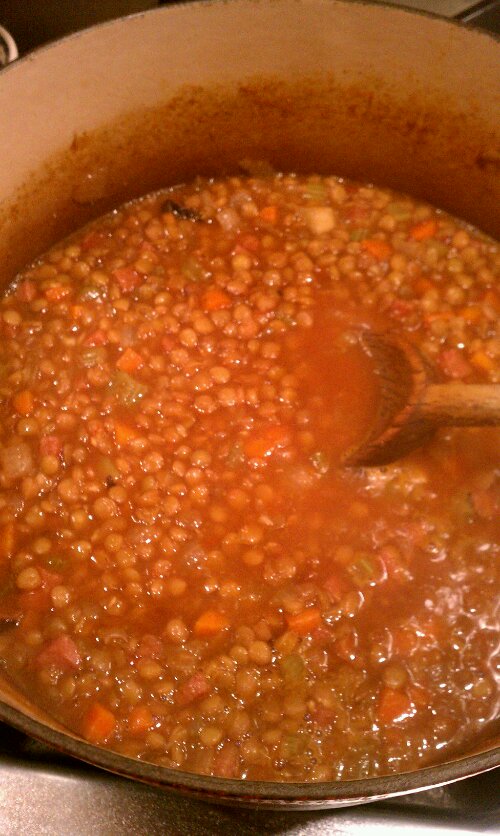The other night, I got “THE PHONE CALL.”
You know, the one where Gabe called to say he was coming home from swim practice with two starving friends. I panicked. It was a Thursday night, which meant that my week’s groceries had pretty much run out. The dinner I had planned to serve was “a little bit of this and a little bit of that,” as my father would say. Now I had to come up with something a little more coherent, not to mention substantial. A frantic survey of the refrigerator’s meager contents revealed three meatballs in about 1/2 cup of tomato sauce, a couple of slices of bacon, and some salad fixings. I rummaged the pantry, which yielded a can of pinto beans, small shell-shaped pasta, and a quart of chicken stock. This showed some promise. An onion, a couple stalks of celery, some broccoli florets, and some frozen peas all got piled on the counter. A carrot would have been a nice addition, if there were any. But there were not. I sent the boys to the supermarket for Italian bread to buy me some time. The soup was nearly finished by the time they arrived, and was completely demolished, along with the salad and an entire loaf of bread, 30 minutes later. Whew.
Leftover Soup (feel free to use plenty of creative license)
3-5 slices bacon, diced
2 tablespoons olive oil
1/2 large onion, sliced
Center stalks of celery, with leaves, chopped (about 1/2 cup)
2 cloves garlic, lightly smashed with the back of a knife
2 cups broccoli florets
1 can pinto beans (or cannelini or garbanzo)
Any random amount of leftover meatballs, cut into 1/2-inch pieces, and a few drops of tomato sauce. Or 2 tablespoons of tomato paste, or 1 cup chopped tomatoes (fresh or canned).
1 quart chicken stock
1 sprig of fresh oregano (optional)
1 rind from a hunk of Parmigiano Reggiano, which you have squirreled away in the fridge
1 cup frozen peas
1 cup small pasta shape (small shells worked perfectly)
1 teaspoon Sriracha hot sauce
Salt and pepper, to taste
Grated Parmigiano Reggiano
Put the diced bacon and the olive oil into a stockpot or Dutch oven. Cook the bacon on medium high until brown and crisp. Remove the bacon with a slotted spoon and drain on paper towels. Set aside. Add the onions, celery, garlic, and 1/2 cup of diced carrots (if you have them) to the pot and cook, stirring occasionally, until they begin to soften, about five minutes. Add the broccoli florets, stir, and cook another five minutes. Add the beans and their liquid. Stir. Toss in the meatballs and sauce. Add the chicken stock and oregano and stir again. Throw in the cheese rind. Cover the pot and bring to a simmer. Meanwhile, in another samll pot, cook the pasta according to package directions. When almost done, add the frozen peas. Drain the pasta and peas, but save the cooking water. No, I am not kidding. After you have added the pasta and peas to the soup, you will find that you need more liquid. Am I right? Go ahead and add as much as you like. Add Sriracha, salt, and pepper to taste. Simmer for a few more minutes until flavors have melded or the ravenous teenage boys start to circle the stove. Garnish with grated cheese and bacon bits.
Serves four, if you are lucky.













